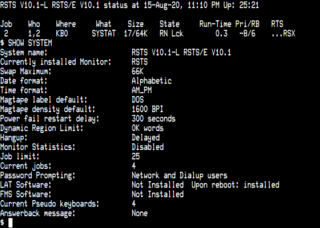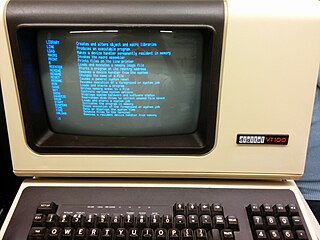Related Research Articles

Multiple Virtual Storage, more commonly called MVS, is the most commonly used operating system on the System/370, System/390 and IBM Z IBM mainframe computers. IBM developed MVS, along with OS/VS1 and SVS, as a successor to OS/360. It is unrelated to IBM's other mainframe operating system lines, e.g., VSE, VM, TPF.
PL/I is a procedural, imperative computer programming language developed and published by IBM. It is designed for scientific, engineering, business and system programming. It has been used by academic, commercial and industrial organizations since it was introduced in the 1960s, and is still used.

Newline is a control character or sequence of control characters in character encoding specifications such as ASCII, EBCDIC, Unicode, etc. This character, or a sequence of characters, is used to signify the end of a line of text and the start of a new one.
ISAM is a method for creating, maintaining, and manipulating computer files of data so that records can be retrieved sequentially or randomly by one or more keys. Indexes of key fields are maintained to achieve fast retrieval of required file records in Indexed files. IBM originally developed ISAM for mainframe computers, but implementations are available for most computer systems.
Peripheral Interchange Program (PIP) was a utility to transfer files on and between devices on Digital Equipment Corporation's computers. It was first implemented on the PDP-6 architecture by Harrison "Dit" Morse early in the 1960s. It was subsequently implemented for DEC's operating systems for PDP-10, PDP-11, and PDP-8 architectures. In the 1970s and 1980s Digital Research implemented PIP on CP/M and MP/M.

RSTS is a multi-user time-sharing operating system developed by Digital Equipment Corporation for the PDP-11 series of 16-bit minicomputers. The first version of RSTS was implemented in 1970 by DEC software engineers that developed the TSS-8 time-sharing operating system for the PDP-8. The last version of RSTS was released in September 1992. RSTS-11 and RSTS/E are usually referred to just as "RSTS" and this article will generally use the shorter form. RSTS-11 supports the BASIC programming language, an extended version called BASIC-PLUS, developed under contract by Evans Griffiths & Hart of Boston. Starting with RSTS/E version 5B, DEC added support for additional programming languages by emulating the execution environment of the RT-11 and RSX-11 operating systems.
Virtual Storage Access Method (VSAM) is an IBM DASD file storage access method, first used in the OS/VS1, OS/VS2 Release 1 (SVS) and Release 2 (MVS) operating systems, later used throughout the Multiple Virtual Storage (MVS) architecture and now in z/OS. Originally a record-oriented filesystem, VSAM comprises four data set organizations: key-sequenced (KSDS), relative record (RRDS), entry-sequenced (ESDS) and linear (LDS). The KSDS, RRDS and ESDS organizations contain records, while the LDS organization simply contains a sequence of pages with no intrinsic record structure, for use as a memory-mapped file.

DIGITAL Command Language (DCL) is the standard command language adopted by many of the operating systems created by Digital Equipment Corporation. DCL had its roots in IAS, TOPS-20, and RT-11 and was implemented as a standard across most of Digital's operating systems, notably RSX-11 and RSTS/E, but took its most powerful form in VAX/VMS. DCL continues to be developed by VSI as part of OpenVMS.
In computing, position-independent code (PIC) or position-independent executable (PIE) is a body of machine code that, being placed somewhere in the primary memory, executes properly regardless of its absolute address. PIC is commonly used for shared libraries, so that the same library code can be loaded at a location in each program's address space where it does not overlap with other memory in use by, for example, other shared libraries. PIC was also used on older computer systems that lacked an MMU, so that the operating system could keep applications away from each other even within the single address space of an MMU-less system.
Files-11 is the file system used in the RSX-11 and OpenVMS operating systems from Digital Equipment Corporation. It supports record-oriented I/O, remote network access, and file versioning. The original ODS-1 layer is a flat file system; the ODS-2 version is a hierarchical file system, with support for access control lists,.
In the context of IBM mainframe computers in the S/360 line, a data set or dataset is a computer file having a record organization. Use of this term began with, e.g., DOS/360, OS/360, and is still used by their successors, including the current z/OS. Documentation for these systems historically preferred this term rather than file.
VSI BASIC for OpenVMS is the latest name for a dialect of the BASIC programming language created by Digital Equipment Corporation (DEC) and now owned by VMS Software Incorporated (VSI). It was originally developed as BASIC-PLUS in the 1970s for the RSTS-11 operating system on the PDP-11 minicomputer. It was later ported to OpenVMS, first on VAX, then Alpha, and most recently Integrity.
In computer science, a record-oriented filesystem is a file system where data is stored as collections of records. This is in contrast to a byte-oriented filesystem, where the data is treated as an unformatted stream of bytes. There are several different possible record formats; the details vary depending on the particular system. In general the formats can be fixed-length or variable length, with different physical organizations or padding mechanisms; metadata may be associated with the file records to define the record length, or the data may be part of the record. Different access methods for records may be provided, for example records may be retrieved in sequential order, by key, or by record number.
On-line Debugging Tool (ODT) is a family of several debugger programs developed for Digital Equipment Corporation (DEC) hardware. Various operating systems including OS/8, RT-11, RSX-11, and RSTS/E implement ODT, as did the firmware console of all of the LSI-11-family processors including the 11/03, 11/23/24, 11/53, 11/73, and 11/83/84.

OS/360, officially known as IBM System/360 Operating System, is a discontinued batch processing operating system developed by IBM for their then-new System/360 mainframe computer, announced in 1964; it was influenced by the earlier IBSYS/IBJOB and Input/Output Control System (IOCS) packages for the IBM 7090/7094 and even more so by the PR155 Operating System for the IBM 1410/7010 processors. It was one of the earliest operating systems to require the computer hardware to include at least one direct access storage device.

In computing, del is a command in command-line interpreters (shells) such as COMMAND.COM, cmd.exe, 4DOS, NDOS, 4OS2, 4NT and Windows PowerShell. It is used to delete one or more files or directories from a file system.

In computing, the print command provides single-user print spooling capability in a number of operating systems. It is roughly similar to that provided by the UNIX System V lp and BSD lpr print spooler systems.

In computing, copy is a command in various operating systems. The command copies computer files from one directory to another.
RTL/2 is a discontinued high-level programming language for use in real-time computing, developed at Imperial Chemical Industries, Ltd. (ICI), by J.G.P. Barnes. It was originally used internally in ICI but was distributed by SPL International in 1974. It was based on concepts from ALGOL 68, and intended to be small and simple. RTL/2 was standardised in 1980 by the British Standards Institution.
The GOFF specification was developed for IBM's MVS operating system to supersede the IBM OS/360 Object File Format to compensate for weaknesses in the older format.
References
- ↑ VAX-11 Record Management Services Reference Manual (PDF). DEC. February 1979. AA-D031B-TE.
- ↑ OpenVMS Record Management Services Reference Manual. June 2002. p. 23. Retrieved 20 November 2017.
- ↑ itec.suny.edu. April 2001 https://www.itec.suny.edu/scsys/vms/ovmsdoc073/v73/6027/6027pro.html . Retrieved 2021-01-03.
{{cite web}}: Missing or empty|title=(help)